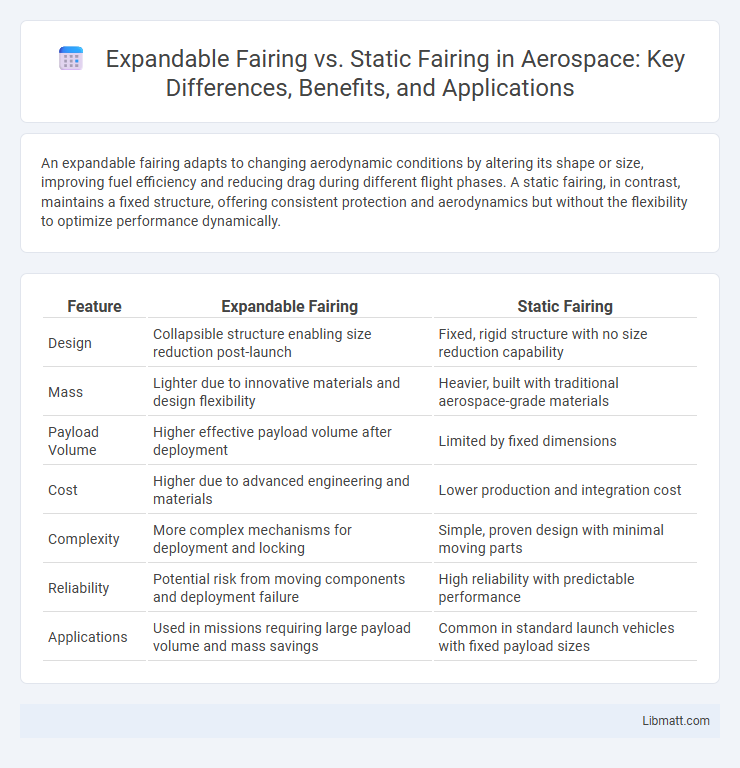An expandable fairing adapts to changing aerodynamic conditions by altering its shape or size, improving fuel efficiency and reducing drag during different flight phases. A static fairing, in contrast, maintains a fixed structure, offering consistent protection and aerodynamics but without the flexibility to optimize performance dynamically.
Table of Comparison
| Feature | Expandable Fairing | Static Fairing |
|---|---|---|
| Design | Collapsible structure enabling size reduction post-launch | Fixed, rigid structure with no size reduction capability |
| Mass | Lighter due to innovative materials and design flexibility | Heavier, built with traditional aerospace-grade materials |
| Payload Volume | Higher effective payload volume after deployment | Limited by fixed dimensions |
| Cost | Higher due to advanced engineering and materials | Lower production and integration cost |
| Complexity | More complex mechanisms for deployment and locking | Simple, proven design with minimal moving parts |
| Reliability | Potential risk from moving components and deployment failure | High reliability with predictable performance |
| Applications | Used in missions requiring large payload volume and mass savings | Common in standard launch vehicles with fixed payload sizes |
Introduction to Rocket Fairings
Rocket fairings protect payloads during launch by shielding them from aerodynamic forces and environmental conditions. Expandable fairings offer a compact design that unfolds to maximize payload volume in space, enhancing efficiency for missions with varying cargo sizes. Static fairings provide rigid, fixed structures optimized for aerodynamic stability and commonly used in traditional launch vehicles.
What is an Expandable Fairing?
An expandable fairing is an aerospace component designed to increase in size after launch to protect payloads during ascent and then compact for efficient deployment or operations in space. Unlike static fairings, which are rigid and fixed in shape, expandable fairings use advanced materials and mechanisms to transform their structure dynamically, optimizing mass and volume constraints. This technology enhances payload flexibility, reduces launch vehicle aerodynamic drag, and can improve overall mission efficiency by minimizing fairing separation risks.
Understanding Static Fairings
Static fairings are aerodynamic components fixed permanently to vehicles or aircraft, designed to reduce drag and improve fuel efficiency by smoothing airflow around structural elements. Unlike expandable fairings that adjust in real-time to changing conditions, static fairings maintain a consistent shape, providing reliable performance without added mechanical complexity or maintenance. Understanding static fairings helps you appreciate their role in enhancing stability and reducing resistance in various engineering applications.
Key Differences: Expandable vs Static Fairings
Expandable fairings adjust dynamically to changing aerodynamic conditions, reducing drag and improving fuel efficiency, while static fairings have a fixed shape optimized for a specific flight phase. The key difference lies in expandability, where expandable fairings provide better adaptability and performance across different speeds and altitudes compared to static fairings. Your choice between the two impacts overall aircraft efficiency, with expandable fairings offering enhanced versatility for varied flight profiles.
Weight and Payload Capacity Comparison
Expandable fairings offer significant weight savings compared to static fairings, typically reducing mass by up to 30%, which directly enhances payload capacity for launch vehicles. Their reduced aerodynamic drag and ability to deploy after ascent allow for larger payload volumes without increasing fairing mass. Static fairings, while structurally simpler, generally incur higher weight penalties that limit overall payload capacity and constrain launch efficiency.
Cost Efficiency and Manufacturing
Expandable fairings offer greater cost efficiency by reducing material usage and enabling compact storage, which lowers shipping and assembly expenses. Their manufacturing process leverages advanced materials and modular designs that streamline production, though initial tooling costs may be higher compared to static fairings. Static fairings are simpler to produce with established manufacturing techniques but often incur higher long-term costs due to bulkier transport and less adaptable assembly requirements.
Reusability and Environmental Impact
Expandable fairings significantly enhance reusability by enabling easier recovery and refurbishment compared to static fairings, which often require extensive repairs or replacement after each flight. Your choice of expandable fairing reduces material waste and lowers environmental impact by minimizing debris and resource consumption. This innovation aligns with sustainable aerospace practices, fostering both cost efficiency and ecological responsibility.
Performance in Launch and Deployment
Expandable fairings offer enhanced performance in launch by reducing aerodynamic drag and improving payload capacity through their compact stowed volume, leading to more efficient fuel usage. Static fairings, while structurally simpler and more robust, often increase the vehicle's drag and limit aerodynamic optimization, potentially reducing launch efficiency. Your mission's deployment phase benefits from expandable fairings due to their ability to adapt shape post-launch, ensuring optimal payload protection without compromising performance.
Current Applications and Case Studies
Expandable fairings are increasingly utilized in aerospace missions requiring adaptable aerodynamic profiles, such as SpaceX's Starship booster, which uses expandable fairings to reduce drag during ascent and then deploy for payload deployment. Static fairings remain common in traditional satellite launches, exemplified by Ariane 5 missions where rigid structures provide reliable payload protection in predictable flight environments. Your choice between expandable and static fairings depends on mission flexibility needs and payload specifications, as demonstrated by these evolving case studies.
Future Trends in Fairing Technology
Expandable fairings are poised to revolutionize aerospace by offering adjustable aerodynamic surfaces that optimize drag reduction and fuel efficiency across varying flight conditions, surpassing the fixed geometry of static fairings. Innovations in smart materials and actuation systems enable real-time shape adaptation, promoting lower emissions and enhanced vehicle performance during launch and ascent phases. Integration of predictive analytics and AI-driven control in expandable fairings aligns with industry trends toward lightweight, multifunctional spacecraft components tailored for reusable launch vehicles.
expandable fairing vs static fairing Infographic

 libmatt.com
libmatt.com